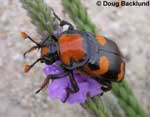The American burying beetle  (Nicrophorus americanus) is a large, shiny, black beetle occurring in the eastern half of the United States (Headstrom, 1977). Its geographic range has been reduced by about 90% in recent years. Previously, the species ranged throughout the eastern half of the United States. Currently, the American burying beetle is restricted to three localities including eastern Oklahoma and western Arkansas, central Nebraska and southern South Dakota, and Block Island, Rhode Island (Lomolino et al., 1995; Holloway and Schnell, 1997; Creighton and Scnhell, 1998). Nicrophorus americanus is quite large, weighing about two grams (Lomolino et al., 1995) and ranging from 27mm to 35mm in length (Headstrom, 1977; Lomolino et al., 1995).
(Nicrophorus americanus) is a large, shiny, black beetle occurring in the eastern half of the United States (Headstrom, 1977). Its geographic range has been reduced by about 90% in recent years. Previously, the species ranged throughout the eastern half of the United States. Currently, the American burying beetle is restricted to three localities including eastern Oklahoma and western Arkansas, central Nebraska and southern South Dakota, and Block Island, Rhode Island (Lomolino et al., 1995; Holloway and Schnell, 1997; Creighton and Scnhell, 1998). Nicrophorus americanus is quite large, weighing about two grams (Lomolino et al., 1995) and ranging from 27mm to 35mm in length (Headstrom, 1977; Lomolino et al., 1995).
Beetles are insects and belong to the group Coleoptera. Coleoptera is not only the largest grouping of insects, but also the largest group of animals in the world (Hickman et al., 1979; Barnes, 1980)! Currently, 300,000 species of beetles have been described. They live in a variety of habitats, although exclusively marine species are unknown. About 98% of beetle species are terrestrial, with the remainder occurring in freshwater and inter-tidal zones (Gillot, 1995).
Beetles have two pairs of wings, the fore wings and the hind wings. The fore wings, or elytra, are specialized, hardened structures that protect the membranous hind wings. When the hind wings are not in use, they fold underneath the elytra and are protected from damage (Headstrom, 1977; Gillot, 1995).
Most beetles are oviparous (Gillot, 1995) and all species have full metamorphosis (Headstrom, 1977; Barnes, 1980). Beetles typically have three periods of development to reach full maturity -- egg, larva, and pupa (Headstrom, 1977). Adaptations for aquatic environments are variable among species. In some species, only larvae have aquatic adaptations while in other species adults are also fully aquatic. Although most aquatic larvae leave the water to pupate, some species construct air-filled cocoons that can be submerged underwater (Gillot, 1995).
Adult and larval American burying beetles feed on carrion (decaying animal flesh) (Lomolino et al., 1995; Holloway and Schnell, 1997; Creighton and Schnell, 1998). Carcasses are buried and consumed underground (Headstrom, 1977). The American burying beetle will eat carrion of small vertebrates and typically carcasses are mammalian or avian (Holloway and Schnell, 1997). Although adults can feed on carcasses of various sizes, larvae require carcasses under 300g (Creighton and Schnell, 1998).
Parental care is substantial during the larval period, lasting until the larvae leave to pupate. Parents help feed their young by burying carcasses (Creighton and Schnell, 1998) and through regurgitation (Lomolino et al., 1995). Additionally, parental secretions slow the decay of carrion allowing larvae ample time to feed off a carcass (Lomolino et al., 1995). Finally, parents protect larvae from predators (Lomolino et al., 1995; Creighton and Schnell, 1998).
In addition to using carrion for feeding, the American burying beetle needs carcasses for reproduction. Carcasses used in reproduction range in size from 80g to 300g. Researchers have suggested that the reduction in the geographic range of the American burying beetle is related to the decline in medium sized vertebrates throughout its previous range and subsequently a lack of appropriately-sized carcasses for reproduction (Lomolino et al., 1995; Holloway and Schnell, 1997; Creighton and Scnhell, 1998).
Other beetles on DigiMorph: Lucanus sp.
Additional Information on the Skull
Click on the thumbnails below for labeled images of the skull in standard anatomical views.

Literature
Barnes, R. D. 1980. Invertebrate Zoology. Saunders College, Philadelphia, PA. 1089 pp.
Creighton, J. C., and G. D. Schnell. 1998. Short-term movement patterns of the endangered American buyring beetle Nicrophorous americanus. Biological Conservation 86:281-287.
Gillot, C. 1995. Entomology. Plenum Press, New York, NY. 798 pp.
Headstrom, H. 1977. The Beetles of America. A. S. Barnes and Co., Inc., Cranbury, NJ. 488 pp.
Hickman, C. P., C. P. Hickman Jr., F. M. Hickman, L. S. Roberts. 1979. Integrated Principles of Zoology. The C. V. Mosby Company, St. Louis, MI. 1086 pp.
Holloway, A. K., and G. D. Schnell. 1997. Relationship between numbers of the endangered American burying beetle Nicrophorous americanus Olivier (Coleoptera: Silphidae) and available food resources. Biological Conservation 81:145-152.
Lomolino, M. V., J. C. Creighton, G. D. Schnell, and D. L. Certain. 1995. Ecology and conservation of the endangered American burying beetle (Nicrophorus americanus). Conservation Biology 9:605-614.
Links
Nicrophorus americanus page on the South Dakota Wildlife Diversity Program site.


